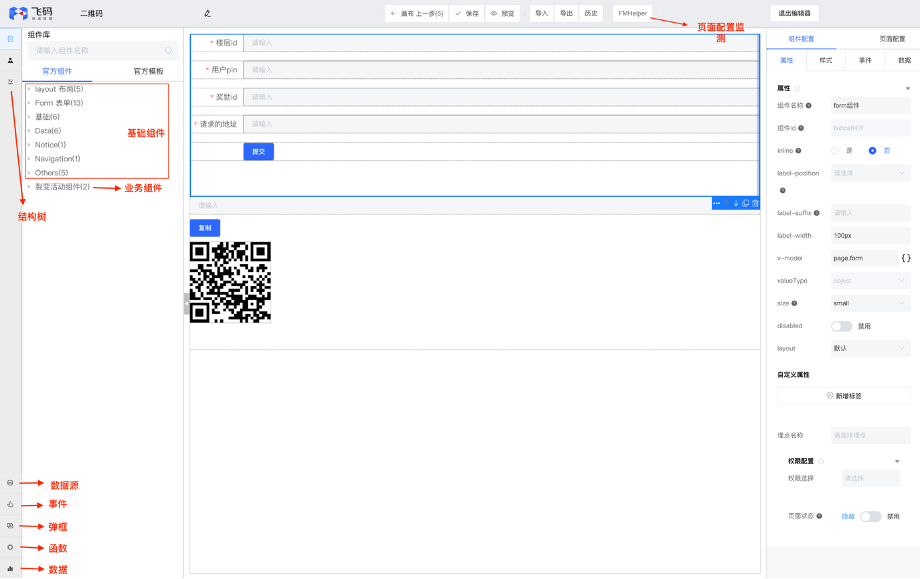首先说明这不是一篇完整解读ExtJS和jQuery所有方面差异的文章,只是针对我个人刚看了两天的jQuery产生的一些疑问的整理。之前用过一段时间ExtJS,了解ExtJS的一些机制。现在做移动开发,又选定了jquery mobile,要写控件,所以需要了解jquery。(不过换工作之后应该不会再用jQuery了,坑估计是短期内填不上了)
1、jQuery是个什么东西?Ext是什么东西?(此处不是指两个框架,而是指我们在写程序的时候,经常用到的两个关键字--暂时称之为关键字)
之前用的是ExtJS,Ext是个Object,通过字面量创建的,Ext.js文件里,3.3.1版:
- Ext = {
- version : '3.3.1',
- versionDetail : {
- major : 3,
- minor : 3,
- patch : 1
- }
- };
4.0版本,此处global == window:
- if (typeof Ext === 'undefined') {
- global.Ext = {};
- }
既然Ext是个Object,那jQuery是不是也是个Object呢?NO,来分析下源码,jquery.js:
- var jQuery = (function() {
- // Define a local copy of jQuery
- var jQuery = function( selector, context ) {
- // The jQuery object is actually just the init constructor 'enhanced'
- return new jQuery.fn.init( selector, context, rootjQuery );
- },
- ...//此处省略900行
- return jQuery;
- })();
此处大概明白了,jQuery是个Function,并且由于此处调用jQuery的时候,有个return,所以var v = jQuery(xxx)和var v = new jQuery(xxx)调用后,v都是同一个函数的实例。在《JavaScript高级程序设计》第18章第一节有提到过这种技巧,叫做作用域安全的构造函数,不过书上提到的形式稍有差异:
- function Person(name,age){
- if(this instanceof Person){
- this.name = name;
- this.age = age;
- }else{
- return new Person(name,age);
- }
- }
这样var p = Person('a',21)和var p = new Person('a',21) ,p就都是Person实例了,如果去掉if判断和else后边的内容,第一种调用p是undefined。
在jquery.js最后,把变量jQuery赋值给了$,后续可以通过$这种简写使用jQuery,算是一个简写的别名吧:
- window.jQuery = window.$ = jQuery;
此处先挖个坑,构造函数中(如此处的Person)的this到底怎么理解?
2、jQuery和Ext在这两个关键字都怎么使用的,有何异同?
2.1、Ext是个对象,是一个命名空间,跟java里头的package类似,使用Ext下边的方法、Function/类的时候,就像使用一个对象的属性一样,如工具方法Ext.apply、Ext.applyIf可以直接调用,构造函数Ext.json.DataStore,前边加new创建实例。关于这么做的好处,了解java package的好处的都知道那么一些吧,我只还记得避免命名冲突。
2.2、jQuery首先是个Function,既然是个Function,那个就可以new,可以像Function一样调用,以下将解析几种jQuery调用方法的源码:
jQuery(xxx)的时候,转调到
- new jQuery.fn.init(selector,context,rootjQuery)
具体调用时候就需要分析jQuery.prototype.init函数了。
2.2.1、jQuery(function(){}),当传入是function的时候,init方法片段:
- else if ( jQuery.isFunction( selector ) ) {
- return rootjQuery.ready( selector );
- }
此处rootjQuery默认又等于jQuery(document);ready实际上就是在为document注册load事件,源码:
- ready: function( fn ) {
- // Attach the listeners
- jQuery.bindReady();
- // Add the callback
- readyList.done( fn );
- return this;
- }
bindReady方法是通过attachEvent/addEventListener为document注册了load事件。
- bindReady: function() {
- if ( readyList ) {
- return;
- }
- readyList = jQuery._Deferred();
- // Catch cases where $(document).ready() is called after the
- // browser event has already occurred.
- if ( document.readyState === "complete" ) {
- // Handle it asynchronously to allow scripts the opportunity to delay ready
- return setTimeout( jQuery.ready, 1 );
- }
- // Mozilla, Opera and webkit nightlies currently support this event
- if ( document.addEventListener ) {
- // Use the handy event callback
- document.addEventListener( "DOMContentLoaded", DOMContentLoaded, false );
- // A fallback to window.onload, that will always work
- window.addEventListener( "load", jQuery.ready, false );
- // If IE event model is used
- } else if ( document.attachEvent ) {
- // ensure firing before onload,
- // maybe late but safe also for iframes
- document.attachEvent( "onreadystatechange", DOMContentLoaded );
- // A fallback to window.onload, that will always work
- window.attachEvent( "onload", jQuery.ready );
- ……
- }
- }
2.2.2、jQuery(DOMElement)当传入参数是一dom element的时候,init方法片段:
- if ( selector.nodeType ) {
- this.context = this[0] = selector;
- this.length = 1;
- return this;
- }
把dom元素放到了new出来的init对象上,此处this应该是一个对象,应该是个Object的,但是从Chrome调试看,此时this竟然显示为jQuery.fn.jQuery.init[0],Object.prototype.toString.call(this)结果是”[object Object]”,是个对象,为何显示这么奇怪呢?在FF里,this显示为[],按照道理说,对象应该不会这么显示的才对。
此处把元素赋值为this[0]可以在后续访问元素的时候,直接用返回实例的[0]来访问,如果是多个元素,则可以用下标一个个的访问,后边看到selector的时候会看到。同时由于后边把init的原型指向了jQuery的原型,所以这里this的原型方法都是jQuery.prototype的方法:
- jQuery.fn = jQuery.prototype = ……
- jQuery.fn.init.prototype = jQuery.fn;
挖坑,关于原型方法,实例的关系。
2.2.3、如果传入是body,jQuery(“body”),返回只有一个body元素
- if ( selector === "body" && !context && document.body ) {
- this.context = document;
- this[0] = document.body;
- this.selector = selector;
- this.length = 1;
- return this;
- }
2.2.4、jQuery(selector),如jquery.mobile.js中initializePage中$(“:jqmData(role=’page’)”)
- // Handle HTML strings
- if ( typeof selector === "string" ) {
- // Are we dealing with HTML string or an ID?
- if ( selector.charAt(0) === "<" && selector.charAt( selector.length - 1 ) === ">" && selector.length >= 3 ) {
- // Assume that strings that start and end with <> are HTML and skip the regex check
- match = [ null, selector, null ];
- } else {
- match = quickExpr.exec( selector );
- }
- // Verify a match, and that no context was specified for #id
- if ( match && (match[1] || !context) ) {
- ……//省略几十行,这一段是避免xss攻击什么的,没读懂,以后再来读
- return this;
- }
- // HANDLE: $(expr, $(...))
- } else if ( !context || context.jquery ) {
- return (context || rootjQuery).find( selector );
- // HANDLE: $(expr, context)
- // (which is just equivalent to: $(context).find(expr)
- } else {
- return this.constructor( context ).find( selector );
- }
- }
如果传入的context为空,就从当前对象查找find(selector)否则就从rootjQuery查找,这里rootjQuery是个实力,所以此方法调用就是调用的原型上的find方法:
- jQuery.fn.extend({
- find: function( selector ) {
- var self = this,
- i, l;
- ……//此处省略10+行
- var ret = this.pushStack( "", "find", selector ),
- length, n, r;
- for ( i = 0, l = this.length; i < l; i++ ) {
- length = ret.length;
- jQuery.find( selector, this[i], ret );
- if ( i > 0 ) {
- // Make sure that the results are unique
- for ( n = length; n < ret.length; n++ ) {
- for ( r = 0; r < length; r++ ) {
- if ( ret[r] === ret[n] ) {
- ret.splice(n--, 1);
- break;
- }
- }
- }
- }
- }
- return ret;
- }
此处又调用到了jQuery.find方法,注意,jQuery是一个Function,这个find跟rootjQuery不同,jQuery.find是function的一个属性,非严格意义上可以简单的认为类似于java的静态方法。此find方法实则是Sizzle本身:
jQuery.find = Sizzle;
具体实现还要看selector的内容,可能是getTagByName或者querySelectorAll,如getTagByName(‘name’)、querySelectorAll(“[data-role=’page’]”)。
2.2.5、jQuery()如果传入为空,则返回不包含元素的jQuery对象:
- if (!selector ) {
- return this;
- }
2.2.6、jQuery(jQuery()),也就是传一个jQuery实例进去,会创建一个新对象,然后把老对象的内容拷贝到新对象里头。
综上,jQuery()返回的是一个jQuery.prototype.init函数的实例,但是由于这个函数的原型指向了jQuery函数的原型,jQuery.prototype上的方法也可以直接在这个实例上调用。同时jQuery会被当成一个数组来使用,根据下标索引提取满足参数的dom元素。
2.3、jQuery接着:-)也起到命名空间的作用。
虽然jQuery是个function,但是可以在function上添加属性(这么叫准确么?)然后就可以直接jQuery.method()、jQuery.filed的调了。这里jQuery至少起到了一个命名空间的作用。
既然说到命名空间了,就不得不说jQuery的原型和function的方法,jQuery.method()类似静态方法,可以通过
- jQuery.method=function(){}
- jQuery.extend({method:function(){}})
两种方法来添加。原型方法则通过jQuery.fn.extend / jQuery.prototype.extend来添加。
3、jQuery和Ext都怎么实现继承的,有什么异同?各有什么优势?
JavaScript是一门基于对象的语言,但不是面向对象,也就是说语言层面没有提供继承的语法,但是可以通过应用层面实现继承。由于把这种实现放到了应用层面,所以实现就变得五花八门了,可以通过拷贝、原型链等。了解两种继承的调用方式对理解下边说到的实现原理是很有帮助的。
3.1、Ext(3.x)的继承跟《JavaScript高级程序设计》里讲到的寄生组合模式类似,这种实现方式复杂,不太容易理解。具体是在当前类和超类之间插入一个空对象,作为子类的原型对象,这个空对象的构造函数的原型指向超类的原型,然后把子类的方法,全部放入到这个空对象上。这样可以做到方法通过原型链实现继承,实例属性通过借用构造函数实现继承。这种方法也是目前最完美的实现方案。ExtJS继承的源码解析参考这里。
3.2、jQuery的继承的实现是基于拷贝的,这种实现比较简单,容易理解。但是要注意的是,jQuery这个function本身和jQuery的原型都有继承方法,其中jQuery.extend是把方法、属性拷贝到function上,后续可以直接通过jQuery.method调用;jQuery.fn.extend是把方法、属性拷贝到jQuery的原型上,后续可以通过jQuery实例(实际是jQuery.fn.init的实例,这个init函数的原型指向jQuery的原型)调用:
- jQuery.extend = jQuery.fn.extend = function() {
- var options, name, src, copy, copyIsArray, clone,
- target = arguments[0] || {}, i = 1,
- length = arguments.length, deep = false;
- // Handle a deep copy situation
- if ( typeof target === "boolean" ) {
- deep = target;
- target = arguments[1] || {};
- // skip the boolean and the target
- i = 2;
- }
- // Handle case when target is a string or something (possible in deep copy)
- if ( typeof target !== "object" && !jQuery.isFunction(target) ) {
- target = {};
- }
- // extend jQuery itself if only one argument is passed
- if ( length === i ) {
- target = this;//如果参数只有一个,target就指向this
- --i;
- }
- for ( ; i < length; i++ ) {
- // Only deal with non-null/undefined values
- if ( (options = arguments[ i ]) != null ) {
- // Extend the base object
- for ( name in options ) {//开始复制
- src = target[ name ];
- copy = options[ name ];
- // Prevent never-ending loop
- if ( target === copy ) {
- continue;
- }
- // Recurse if we're merging plain objects or arrays
- if ( deep && copy && ( jQuery.isPlainObject(copy) || (copyIsArray = jQuery.isArray(copy)) ) ) {
- if ( copyIsArray ) {
- copyIsArray = false;
- clone = src && jQuery.isArray(src) ? src : [];
- } else {
- clone = src && jQuery.isPlainObject(src) ? src : {};
- }
- // Never move original objects, clone them
- target[ name ] = jQuery.extend( deep, clone, copy );
- // Don't bring in undefined values
- } else if ( copy !== undefined ) {
- target[ name ] = copy;
- }
- }
- }
- }
- // Return the modified object
- return target;
- };
需要特别注意的是这个this,当jQuery.extend的时候,this指的是jQuery.fn.init这个function,后续的方法、属性复制是复制给function的;当通过jQuery.fn.extend的时候,this指向的是原型对象,后续的方法、属性复制是复制给了原型对象。








